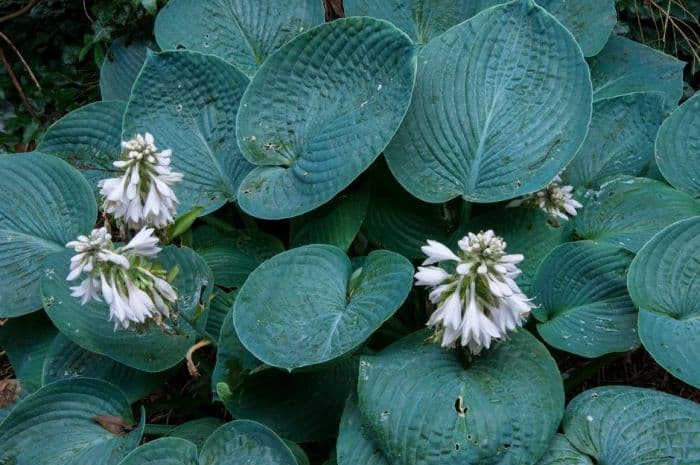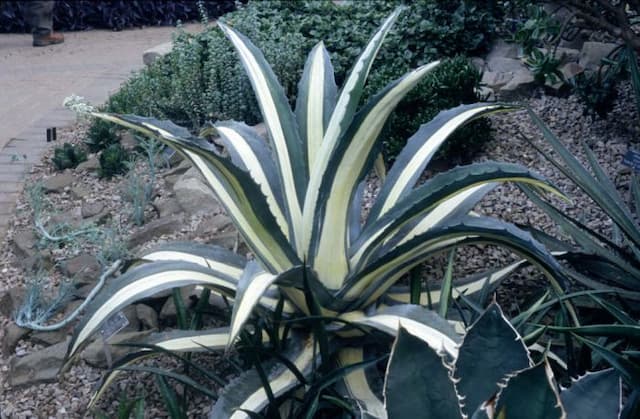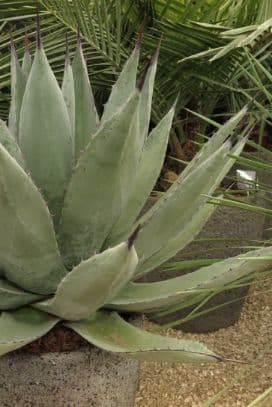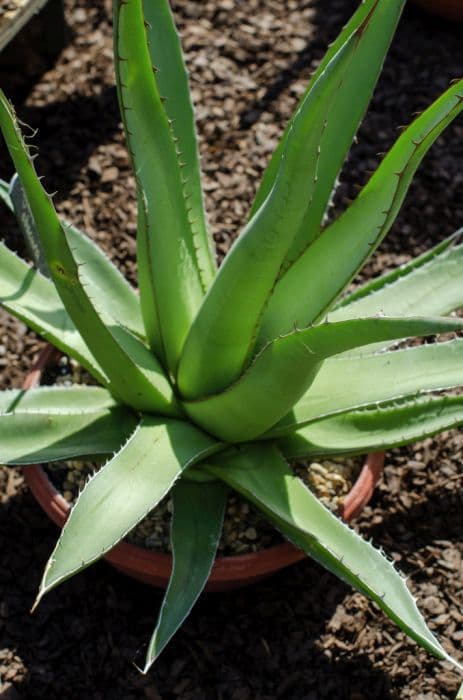Hosta Hosta 'Sea Grotto'

ABOUT
The Hosta 'Sea Grotto' is a visually striking perennial known for its lush foliage. The leaves of 'Sea Grotto' exhibit a unique coloration pattern, where the center is a deep blue-green, surrounded by a contrasting creamy-white margin. This variegation makes it a standout in any garden setting. The leaves are typically heart-shaped with a prominent veining pattern that adds texture to the overall appearance. During the blooming season, 'Sea Grotto' produces flowers on tall spikes that rise above the foliage. The flowers are usually lavender or pale purple, bell-shaped, and clustered together, creating a delicate display. The contrast between the flowers and the variegated leaves is quite eye-catching. Overall, Hosta 'Sea Grotto' is treasured for its decorative leaves and its ability to add a touch of elegance to shady garden spots with its subtle but striking combination of colors and the graceful form of its foliage and flowers.
About this plant
 Names
NamesFamily
Asparagaceae
Synonyms
Plantain Lily, Hosta, Funkia
Common names
Hosta 'Sea Grotto'.
 Toxicity
ToxicityTo humans
Hosta plants are generally not considered highly toxic to humans. However, if ingested in large quantities, they may cause mild stomach upset. Although severe poisoning is rare, it's advisable to keep all plants out of the reach of small children who might chew on them.
To pets
Hostas are known to be poisonous to pets, particularly dogs and cats. If your pet consumes parts of the plant, it may experience symptoms such as vomiting, diarrhea, and depression. In more severe cases, the ingestion could lead to complications such as respiratory distress or an upset in the animal's nervous system. It is important to prevent your pets from accessing and ingesting this plant to avoid these potential health issues.
 Characteristics
CharacteristicsLife cycle
Perennials
Foliage type
Deciduous
Color of leaves
Varies
Flower color
Lavender
Height
1.5 feet (45 centimeters)
Spread
2 feet (60 centimeters)
Plant type
Herb
Hardiness zones
3
Native area
Asia
Benefits
 General Benefits
General Benefits- Shade Tolerance: Hostas, including the 'Sea Grotto' variety, thrive in shaded areas where other plants might not perform as well.
- Low Maintenance: This plant requires minimal care once established, making it ideal for gardeners of all levels.
- Aesthetic Appeal: With its attractive foliage, 'Sea Grotto' adds visual interest to any garden space.
- Erosion Control: The dense growth habit of Hostas can help to prevent soil erosion in your garden.
- Variety: 'Sea Grotto' offers unique coloration and texture, increasing the biodiversity of your plant selection.
- Seasonal Interest: Hostas have a long growing season with foliage from spring to fall and flowers that add a different look in the summer.
- Cold Hardy: 'Sea Grotto', like most Hostas, is robust in cooler climates and can endure winter temperatures with appropriate care.
- Space Filler: They can effectively cover large areas, filling in gaps and suppressing weeds with their extensive foliage.
 Medical Properties
Medical PropertiesThis plant is not used for medical purposes.
 Air-purifying Qualities
Air-purifying QualitiesThis plant is not specifically known for air purifying qualities.
 Other Uses
Other Uses- As a natural dye source: The leaves of Hosta can be used for creating natural dyes for coloring fabrics or other materials in various shades of green depending on the mordant used.
- Leaf casting: Hosta leaves can be used for leaf casting — creating concrete or plaster ornaments for the garden that capture the detailed veining of the leaves.
- Educational tools: Their diverse leaf shapes and sizes make them excellent specimens for educational purposes, such as teaching about leaf anatomy or plant identification.
- In art projects: The large, decorative leaves can be pressed and dried to use in various types of artwork, such as botanical collages or herbarium collections.
- As a texture contrast in floral arrangements: Hosta leaves can add a lush, green backdrop to cut floral arrangements, providing contrast in texture and color.
- Photo backdrop: The large and attractive foliage can serve as a natural backdrop for close-up photography of insects or other small plants.
- Culinary decoration: While not widely known for their edibility, the leaves can be used as a decorative plating element to add a touch of elegance to gourmet dishes.
- Companion planting: Hosta can be used strategically in the garden to highlight the colors and textures of surrounding plants, playing a supporting role in garden design.
- Leaf printing: The leaves can be painted with different colors and pressed onto paper or fabric to create unique leaf print patterns.
- As wrapping material: In a pinch, the large leaves can be used as a natural wrapping material for protecting delicate items briefly or covering up potted plant soil for a neater appearance.
Interesting Facts
 Feng Shui
Feng ShuiHostas are not specifically used in Feng Shui practice.
 Zodiac Sign Compitability
Zodiac Sign CompitabilityHostas are not used in astrology practice.
 Plant Symbolism
Plant Symbolism- Resilience: Hostas, often known as Plantain Lilies, are known for their ability to thrive in shade and their hardiness in various soil conditions, representing the ability to endure and adapt through challenging circumstances.
- Strength: With their lush foliage that returns year after year, Plantain Lilies symbolize inner strength and the reliability of nature’s cycles.
- Devotion: Their perennial nature and the way they grow larger with each coming year makes Plantain Lilies a symbol of steadfastness and devotion in relationships and personal commitments.
- Self-care: Hostas require adequate care, particularly when they are establishing roots. As such, they remind us of the importance of nurturing and looking after oneself.
 Water
WaterHostas, including 'Sea Grotto', prefer consistently moist soil, so water them deeply once a week with about one gallon of water per plant. During hot or dry weather, they may require more frequent watering, possibly twice a week, to maintain soil moisture. It's important to avoid overhead watering to reduce the risk of leaf diseases; instead, water at the base of the plant. In climates with regular rainfall, natural precipitation may suffice, but always check the soil moisture and water as needed.
 Light
LightHostas thrive in dappled shade to partial sun. 'Sea Grotto' will do best in a location where it can receive morning sunlight and afternoon shade, as too much direct sun can scorch its leaves. An ideal spot is under the canopy of open-branched trees or on the north side of buildings where bright indirect light is prevalent.
 Temperature
TemperatureHostas are hardy and 'Sea Grotto' can typically withstand temperatures down to about 30 degrees Fahrenheit, but not sustained freezing. The best growing temperatures are between 50 and 80 degrees Fahrenheit. Hostas emerge in spring once temperatures consistently stay above freezing and thrive through the warm summer months.
 Pruning
PruningPruning hostas, like 'Sea Grotto', involves removing dead or damaged leaves as needed throughout the growing season to maintain plant health and appearance. Cut back the entire plant after the first hard frost in fall to prepare it for winter. Dividing hostas is best done in the spring but can be performed whenever necessary to control their size and spread.
 Cleaning
CleaningAs needed
 Soil
SoilHostas prefer well-draining soil rich in organic matter with a slightly acidic to neutral pH of 6.5-7.5. You can create the best soil mix by combining equal parts of garden soil, peat moss, and perlite or coarse sand to enhance drainage.
 Repotting
RepottingHostas typically require repotting every 3 to 5 years or when they become root-bound. It's best to repot Hostas in the early spring before the leaves fully develop.
 Humidity & Misting
Humidity & MistingHostas thrive in average to high humidity environments. They prefer a humidity level around 50% but are tolerant of a wide range of conditions.
 Suitable locations
Suitable locationsIndoor
Place Hosta in bright, indirect light and ensure good airflow.
Outdoor
Plant in shade to partial sun, protect from strong winds and afternoon sun.
Hardiness zone
3-9 USDA
 Life cycle
Life cycleHostas, including the variety 'Sea Grotto', begin their life cycle when seeds are sown and germinate, although gardeners often propagate them vegetatively by dividing mature plants. After germination, seedlings emerge and develop into young plants with characteristic large leaves, a stage which involves rapid vegetative growth and establishment of the root system. As the plant matures into the adult phase, it forms a clump of heart-shaped to oval foliage that can be variegated or solid in color, depending on the cultivar. Each year, in late spring to early summer, hostas produce tall flower stalks that rise above the foliage, bearing funnel-shaped or bell-like flowers, which are usually lavender or white and can attract bees and other pollinators. Following pollination, seed capsules develop and eventually dry, releasing seeds to complete the reproduction cycle. During the winter months, hostas enter a dormant period where the foliage dies back to the ground, conserving energy for the next growing season.
 Propogation
PropogationPropogation time
Spring-Early Summer
The Hosta 'Sea Grotto', traditionally known as Hosta, is most commonly propagated through division. This process typically takes place in the early spring or fall when the plant is not actively growing. The most popular method involves gently digging up the entire plant and then carefully separating the crown and root system into smaller sections. Each section should have at least two to three shoots and a portion of the root system attached to ensure that it has the necessary elements to re-establish itself when replanted. These divisions can then be replanted in appropriately prepared soil, spaced adequately to accommodate future growth, and watered in to help establish the new plants. It is crucial to maintain even moisture in the soil during the initial phases of growth until the divisions take root and begin to grow independently.









